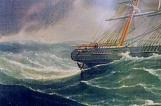1
'The Voyage of Many Rudders' is the most famous of all the tales of Yarmouth shipping. It was so well-known that Archibald MacMechan in his book "Old Province Tales" (published by McClelland & Stewart, Publishers, Toronto, 1924) included a whole chapter on the story. This he called 'The Saga of 'Rudder' Churchill' and is included below in an edited version.
Illustrations which help to understand this true story include a painting and a drawing of the major events as well as documents pertaining to it. Finally, also included are artifacts from the Yarmouth County Museum which were presented to the captain and the mate for their exploits in this 'saga'.
'In the great days of sail, all the counties of Nova Scotia built wooden ships, but Yarmouth county, and shire-town, stood apart in a class by themselves. Nothing ever shook the primacy of Yarmouth as the most maritime county of a maritime province. Bright, hospitable Yarmouth town is built on shipping, and 'Ab Urbe Condita', Yarmouth families have followed the sea. From generation to generation, Lovitts, Canns, and Killams, Hatfields, Cooks and Churchills have commanded ships with varying fortunes in every ocean. The historic shallop 'Pompey' of twenty-five tons, which brought the first settlers to the county in 1761, became the fruitful mother of whole fleets, of every rig and every size, until Yarmouth could boast the largest 'per capita' tonnage of any port in the world.
Perhaps the reason for Yarmouth's pride in her ships and sailor-men may appear from this true tale of the ship 'Research' and her commander, 'Rudder' Churchill.
2
Portrait of the ship 'Research' of Yarmouth, Nova Scotia
1867
Yarmouth, Nova Scotia
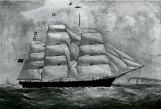
3
The 'Research' was a large, full-rigged ship of 1459 tons burden, built in Yarmouth, in 1861, by Thomas Killam, a well known merchant of that town. On November 10th, 1866, she sailed from Québec deeply laden with ton-timber consigned to William Lindsay & Co. of Glasgow. Besides the timber in her hold, she carried a deck-load of deals, packed and lashed and wedged together into an immovable mass. It was very late in the season for such a voyage.
4
Capt. George Washington Churchill, master of the ship 'Research'
1867
Yarmouth, Nova Scotia

5
Her captain was George Churchill of Yarmouth, aged twenty-nine. He was a navigator of much experience, well reputed for having extricated his ship from dangerous situations, and for once having saved it from destruction by fire. The first mate was his nephew, Aaron Flint Churchill, a young giant of sixteen. He had already been two years at sea, and he was second in command by virtue of his ability, and not by any Board of Trade certificate. George Marshall, also a Yarmouth man, was boatswain, and every inch a sailor.
6
Aaron Flint Churchill, mate of the ship 'Research'
1900
Yarmouth, Nova Scotia

7
More than a fortnight was spent in getting down the river, but, by the night of November 26th, the 'Research' was clear of the dangerous straits of Belle Isle, and fairly out on the Atlantic. That night, the wind almost died away, and the barometer fell to 28°, a most ominous hint of trouble to come. Every precaution was taken. With all made snug, as the sailors say, the 'Research', stripped like an athlete, awaited the onslaught of the storm. All night the uncanny lull continued, but with the morning the tempest broke. Out of the northwest it came, a typical winter storm from the frozen Pole. It ripped the three topsails from the yards and flung them on the waves, leaving only streamers of canvas whipping from the bolt-ropes. Worse was to follow.
8
The ship 'Research' of Yarmouth, Nova Scotia
1867
Yarmouth, Nova Scotia
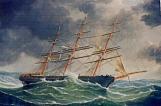
9
A tremendous sea struck the rudder and broke the rudder-stock a little below the 'casing', or opening in the stern through which the stock passes, to connect with the tiller and wheel. The same deadly blow snapped the half-inch links of the rudder-chains. The latter led from a large ring-bolt on the back of the rudder to the rail, or the quarter. They might be called emergency, or safety, chains, because if the stock were broken, the ship could still be steered by means of tackles shackled on to them. Now both stock and chains were broken. The vessel was definitely out of control. The gale, which began with such force, continued, with one brief lull, for a whole month, growing ever worse and worse.
10
Diagram of a wooden ship's rudder
1963
Yarmouth, Nova Scotia
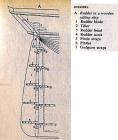
11
Short of total dismasting, the plight of the 'Research' could hardly be more desperate. She could carry no sail; her rudder was useless, and worse then useless, for it was pounding heavily against the rudder post. Without a sail, without a rudder, the 'Research' drove helplessly before the winter storm. A rudderless ship in a storm is a proverb for impotence and disaster.
12
A stormy North Atlantic
1867
Yarmouth, Nova Scotia
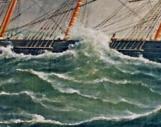
13
Something must be done, and George Churchill was not the man to fold his hands and resign himself to calamity. Attempts were made to pass a hawser over the stern, around the wildly flinging rudder, and so hobble it. The expedient served only for a short time. The hawser chafed through, and the pounding rudder began to break up. How to fetter the massive piece of mechanism and prevent further damage was the problem. If tackles could be affixed to the big ring-bolt on the back of the rudder, it could be controlled, and the ship steered from the deck. But the rudder of a loaded vessel is practically all under water, and the 'Research' was wallowing in mountainous seas. The first thing to do was to lighten the ship aft and so bring the ring-bolt to the surface. The careful stowage of the deck-load had to be undone, and the bright, fresh-cut deals thrown overboard. It was a long and dangerous job, but it was done.
14
Aaron Churchill attempting to secure the rudder of the 'Research'
1867
Yarmouth, Nova Scotia
